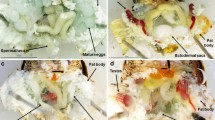Abstract
In temperate climates, phases of growth and dormancy of insect species must cope with the annually fluctuating weather conditions. Instead of quiescence, a prospective and hormonally controlled diapause prevents insect development outside of the season, even when environmental conditions are still advantageous. The induction, maintenance and termination of diapause as well as the resulting adaptive significance of various life-cycle strategies have been studied in detailed ecophysiological analyses (for recent reviews, see Danks 1987; Tauber et al. 1986; Zaslavski 1988). Many lepidopterous species respond to environmental factors during their larval instars, sometimes far in advance of the beginning of their diapause. Other species seem to develop independently of external cues (Friedrich 1983). Both extrinsic and intrinsic factors can regulate the life-cycles of these animals regardless of whether they are polycyclic species, with at least two generations within 1 year, or monocyclic species, with a single reproduction period every year (see e.g. Tauber and Tauber 1973).
Access this chapter
Tax calculation will be finalised at checkout
Purchases are for personal use only
Preview
Unable to display preview. Download preview PDF.
Similar content being viewed by others
References
Alberti B (1958) Des problèmes dans le groupe de Zygaena transalpina. Bull Soc Entomol Mulhouse, pp 1–8
Alberti B (1959) Sur l’éxtension du groupe de Zygaena transalpina en France. Bull Soc Entomol Mulhouse, pp 35–36
Barnes HF (1952) Studies in fluctuations in insect populations. XII. Further evidence for prolonged larval life in the wheat blossom midges. Ann Appl Biol 39: 370–373
Beck SD (1980) Insect photoperiodism. Academic Press, New York
Burgeff H (1910) Beiträge zur Biologie der Gattung Zygaena. II. Z Wiss Insekt Biol 6: 39–44, 97–98
Burgeff H (1921) Beiträge zur Biologie der Gattung Zygaena. TV. Mitt Munch Entomol Ges 11:50–64
Danks HV (1987) Insect dormancy: an ecological perspective. Biological Survey of Canada Monograph Series no 1. Biological Survey of Canada, Ottawa
Dutreix C (1985) Les collections entomologiques du museum d’histoire naturelle Nantes. Révision du genre Zygaena. Bull Soc Sci Nat Ouest de la France N.S. 7: 117–125
Falkovich MI (1979) Seasonal development of desert Lepidoptera of Soviet Central Asia and a historical analysis of the Lepidoptera fauna. Entomol Rev 58: 20–45
Friedrich E (1983) Handbuch der Schmetterlingszucht. Franckh (Keller & Co.), Stuttgart
Harvey GT (1967) On coniferophagus species of Choristoneura (Lep., Tortricidae) in North America. V. Second diapause as a species character. Can Entomol 99: 486–503
Hofmann A, Reiss G (1982) Beitrag zur Zygaenenfauna Nordafrikas. II. Atalanta 13: 136–153
Kaestner A (1973) Lehrbuch der Speziellen Zoologie 5, Insecta B (Spezieller Teil). Fischer, Jena, pp 534–574
Lounibos LP, Bradshaw WE (1975) A second diapause in Wyeomyia smithii: seasonal incidence and maintenance by photoperiod. Can J Zool 53: 215–221
Maixner B, Wipking W (1985) Zygaenidae Fabr. Mitt Arbeitsgem rhein-westf. Lepidopterol 4:103–211
Matthes E (1953) Diapause, Bivoltinismus und zweimalige Überwinterung bei Fumea crassiorella (Lep., Psychidae). Mem Est Mus Zool Univ Coimbra 220: 1–16
Naumann CM, Feist R, Richter G, Weber U (1984) Verbreitungsatlas der Gattung Zygaena Fabricius 1775. Theses Zool 5. Cramer Verlag, Braunschweig
Pörschmann M (1986) Morphologische und habituelle Parameter im larvalen Entwicklungszyklus von Zygaena trifolii (Esper 1783). Diplom-Thesis, Universität Bielefeld Schweizerischer Bund für Naturschutz (1987) Tagfalter und ihre Lebensräume. Fotorotar Verlag, Egg ZH
Sorauer P (1956) Handbuch der Pflanzenkrankheiten, vol 5. Parey, Berlin
Sotavalta O, Karvonen EI, Karvonen EE, Korpela S, Korpela J, (1980) The early stages and biology of Acerbia alpina (Lep., Arctiidae). Not Entomol 60: 89–95
Tauber MJ, Tauber CA (1973) Insect phenology: criteria for analyzing dormancy and the forecasting postdiapause development and reproduction in the field. Search Agric Cornell Univ. Agric Exp Stat Ithaca NY 3: 1–16
Tauber MJ, Tauber CA, Masaki S (1986) Seasonal adaptations of insects. Oxford University Press, New York
Walter H, Lieth H (1960) Klimadiagramm-Weltatlas. Fischer, Jena
Wipking W (1985) Ökologische Untersuchungen über die Habitatbindung der Zygaenidae. Mitt Münch Entomol Ges 74: 37–59
Wipking W (1987) Ökologische Untersuchungen über die Diapauseregulation bei westpaläarktischen Stämmen einer Schmetterlingsfamilie (Ins., Lepidoptera, Zygaenidae). PhD thesis, Universität zu Köln
Wipking W (1988a) Repeated larval diapause and diapause-free development in geographic strains of the burnet moth Zygaena trifolii Esp. I. Discontinuous clinal variation in photoperiodically controlled diapause induction. Oecologia 77: 557–564
Wipking W (1988b) Bivoltinismus und repetitive Larvaldiapause bei Zygaena trifolii Esp. Verh Dtsch Zool Ges 81: 334–335
Wipking W, Neumann D (1986) Polymorphism in the larval hibernation strategy of the burnet moth Zygaena trifolii. In: Taylor F, Karban R (eds) The evolution of insect life cycles. Springer, Berlin Heidelberg New York, pp 125–134
Zaslavski VA (1988) Insect development. Springer, Berlin Heidelberg New York
Editor information
Editors and Affiliations
Rights and permissions
Copyright information
© 1990 Springer-Verlag London Limited
About this paper
Cite this paper
Wipking, W. (1990). Facultative and Obligatory Diapause Responses in Three Species of Burnet Moth: A Characterization of Life-Cycle Phenologies by Field Observations and Laboratory Experiments. In: Gilbert, F. (eds) Insect Life Cycles. Springer, London. https://doi.org/10.1007/978-1-4471-3464-0_16
Download citation
DOI: https://doi.org/10.1007/978-1-4471-3464-0_16
Publisher Name: Springer, London
Print ISBN: 978-1-4471-3466-4
Online ISBN: 978-1-4471-3464-0
eBook Packages: Springer Book Archive



